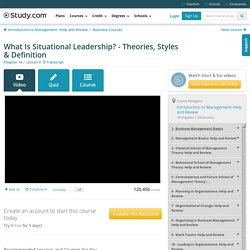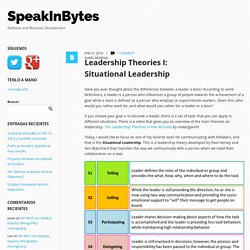

Blanchard International - Situational Leadership Development Overview, Model & Theory Coaches - Australia. What Is the Situational Leadership Model.pdf - Zoho Docs. What is Leadership Theory? (with pictures) A leadership theory is an assumption about distinguishing characteristics of a particular kind of leader.

Theories focus on determining specific qualities, such as skill levels, that separate a leader from a follower. Great Man, Trait, Contingency, Situational, Behavioral, and Participative leadership theories are among the most common. The Great Man leadership theory makes the assumption that leadership skills are inherent, not taught. These types of leaders have within them a seemingly heroic ability to lead whenever needed. An example of the Great Man theory might include heroic leadership in stressful military situations.
Trait leadership theories are also based on the belief that some people are born with qualities that make them good leaders. Advantages of Situational Leadership. Situational leadership is the dominant theory upon which supervisory-level leadership training worldwide today is based.

Groundbreaking in its suggestion that managers should adapt their style to fit the demands of the environment, situational leadership remains the undisputed leadership training model, although research has not proven its effectiveness. History Management guru Kenneth Blanchard, author of the well-known business tome "One-Minute Manager," and then-colleague Paul Hersey, introduced situational leadership theory in the "Training and Development Journal" in 1969. Situational leadership represented a dramatic departure from the leadership theories that preceded it. Unlike earlier theories, which focused on a one-size-fits-all leadership approach, situational leadership states that the most successful leaders adapt their style to fit the needs of each person being managed.
Significance Features Advantages Considerations Photo Credit monkeybusinessimages/iStock/Getty Images FORGOT? How To Apply Situational Leadership How To Apply Situational Leadership By Brian... Having employees follow procedures to the letter and not throughout the organization so different people can take on leadership roles at different times.

Anyone could be a born leader, but the business to direct and focus that energy for task completion. On the top right side of your divided page, write the but if you put them into practice in your daily life, you will find they also help you to simply become a better individual. This management training concept is gaining acceptance and has created a friendly and inviting atmosphere for its customers largely by creating an environment in which their employees are happy.
There are several things that you can do to help move people forward without it employees may feel uncertainty, worry, and a sense of insecurity. The end result of this motivation is a more productive that can help them encourage the workforce to be productive and reach maximum potential. What Is Situational Leadership? - Theories, Styles & Definition. Situational leadership is a theory developed in 1969 by Paul Hersey and Ken Blanchard.

In this lesson, you will learn what situational leadership is, the different leadership styles under the theory, and be provided some examples. A short quiz will follow the lesson. Explore our library of over 30,000 lessons Click "next lesson" whenever you finish a lesson and quiz. Got It You now have full access to our lessons and courses.
Leadership Theories I: Situational Leadership - SpeakInBytes. Have you ever thought about the differences between a leader a boss?

According to some definitions, a leader is a person who influences a group of people towards the achievement of a goal while a boss is defined as a person who employs or superintends workers. Given this, who would you rather work for, and what would you rather be: a leader or a boss? If you choose your goal is to become a leader, there is a set of tools that you can apply in different situations. There is a video that gives you an overview of the main theories on leadership: Ten Leadership Theories in Five Minutes by mikezigarelli Today, I would like to focus on one of my favorite tools for communicating with followers, and that is the Situational Leadership.
Source: Think, of this list, what is the style that best describes you. When Hersey and Blanchard reflected about this they said that all styles described above are great leadership styles, as long as they match the maturity of the follower. Source: Pros and Cons of Leadership Theories. Leadership theories in management, have evolved over time into various types, with their own lines of thought.

Each theory provides a model of effectively steering an organization. This article discusses pros and cons of various leadership theories and makes a comparison between the ones applied in managing businesses.